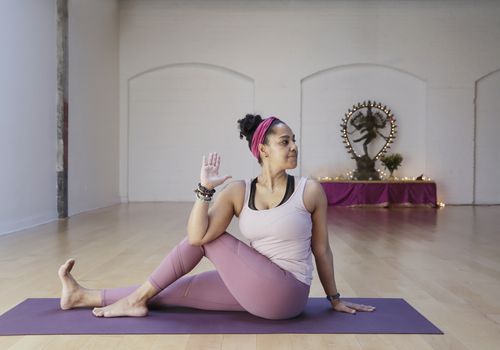
The modern practice of yoga has seen a lot of changes over the last decade. Some critics think this is a bad thing. Andrea Jain writes in an article for The New York Times that yoga has been largely consumed as a way to improve self-esteem and fitness as a response to capitalism, colonialism, globalization, and other developments. Many yoga practitioners now recommend yoga as part and parcel of their daily practice. They believe it can improve physical appearance, reduce stress, and strengthen their bodies.
Modernization can be seen as a rape or theft from the original tradition. It is easy to compare the rise of yoga to an invasion. Although its popularity has not diminished, some controversy have emerged over the years. Modern yoga's popularity in Western societies can indicate a bigger problem. While it is becoming more popular in recent years due to its popularity, its roots are still in an ancient practice.

Although yoga is a tradition that dates back thousands years, it is still very popular in North America. There are many types of yoga. However, most are based on similar principles. Hatha yoga, the most popular form is yoga. Although there are differences between styles of yoga, most practitioners practice it in a private setting, and the most common type of modern yoga is 'hatha'. While it is unclear where the origins of yoga are, a few facts are known.
The historical context of modern yoga is often what reflects the main differences between traditional and modern yoga. Some yoga styles are more focused on spiritual practice than they are on physical exercise. Others place more emphasis on meditation, while others focus on spiritual self realization. Some styles are both religious and secular, while others are pure philosophical. Modern yoga is a blend of both. It is difficult to decide which style you prefer because of its variety.
Ida C. Craddock was the first modern yogi. She is an American social activist who founded the Church of Yoga 1899. She recreated the tantric mysticoerotical aspects of Hatha Yoga and considered God a third spouse in marriage. She was charged with obscenities and spent three months behind bars in 1902. In response to the protest, she hung herself. Today, the practice of yoga is legal in most countries, but the earliest versions of the practice were banned in some states.

These traditions inspired the modern practice of yoga. It is said that yoga is good for all. The Shiva Samhita promises a healthy body and the ability of attracted sexes. Yoga is said to improve the human body in early Hindu texts. But they don't mention whether it offers the same spiritual or physiological benefits. There are many differences between the earliest versions of Hindu yoga and Christian yoga. But both share some characteristics.
FAQ
How does mental health affect my relationships?
Your mental health has an impact on every area of your life. Your ability to function at work, school, home and at school can be affected. It can be difficult to build meaningful relationships due to mental health issues.
A mental health condition can make it easy to isolate oneself from others. You may even avoid social situations because you feel like no one understands you.
However, it's important to remember that people want to be around you. They just need to know how to approach you.
Talking to others about your feelings can help you connect with them. Ask them to help you.
Is mental health more important than work?
Everybody needs to be healthy, especially when they are working. Relaxing at work can make you feel more relaxed. You might try going out with friends or taking a walk outside.
You should speak to your boss if you are struggling with relaxation. You might find ways to reduce your stress.
You should also take care of your physical well-being as well. You should eat right, exercise, and get plenty of rest.
Here are five ways to improve your emotional and mental health.
-
Exercise - Physical activity improves brain function and increases energy levels.
-
Sleep - A good way to reduce anxiety and stress is to get enough sleep.
-
Nutrition - Eating healthy foods such as fruits and vegetables will help keep your body strong and energized.
-
Meditation - Regular meditation reduces stress and anxiety.
-
Socialization - Spending time in the company of friends and family keeps us happy.
What causes mental health problems in adolescents
Adolescence is when we develop our identities. We begin to figure out who we are as individuals and where we fit into society.
These times are also a good time to make new friendships or romantic connections. These experiences can be stressful.
Stress is normal, but if you find yourself experiencing more than usual amounts of stress, then you should seek help.
You might think you can handle things independently, but sometimes, you need someone else to talk to.
During times of stress, your family members and friends can be there for you. They can also teach you ways to manage stress.
You could try meditation or exercise. Both of these activities can help to reduce stress.
A group, such as a church or sports team, is another option. You will meet new people and make new friendships.
What are some signs of mental-emotional difficulties?
Any condition that causes major distress or impairment in functioning can be considered mental disorder. Anxiety, depression, schizophrenia, borderline personality disorder and obsessive compulsive disorder are all examples of mental disorders.
How do you know if you have a mental illness?
An individual may be diagnosed if they experience symptoms that disrupt their daily activities. Different symptoms can indicate mental illness. The most common signs are: sadness and anxiety; feeling guilty, hopeless; lonely; depressed; confused; worthless; guilty, suicidal.
If a person meets at least three of the four criteria below, they may be diagnosed with a mental disorder.
-
Troubled thoughts or feelings
-
Unruly behavior
-
Disturbance in functioning
-
Inability to relate to others
Statistics
- More than 40 million adults in the United States have an anxiety disorder, but less than 37% of people seek mental health treatment for their symptoms. (talkspace.com)
- Similarly, for positive mental health, there is likely to be substantial agreement about some typical components (e.g., resilience to stress) 6, and controversy about more atypical components (e.g., career consolidation). (ncbi.nlm.nih.gov)
- Appropriate nutrition and exercise are likely among the most efficacious and cost-effective positive mental health interventions. (ncbi.nlm.nih.gov)
- In any given year, an estimated 18.1% (43.6 million) of U.S. adults ages 18 years or older suffered from any mental illness, and 4.2% (9.8 million) (healthypeople.gov)
- It does have some influence, but not nearly as much as we might think, so focusing less on attaining wealth will likely make you happier (Aknin, Norton, & Dunn, 2009); (positivepsychology.com)
External Links
How To
How to Determine if a Mental Health Expert is needed
You should look out for signs that indicate that you might need professional assistance to determine if your problem needs to be addressed. You should consult a doctor immediately if you see any of these warning signs.
-
It's as if you feel out of control.
-
You have trouble sleeping.
-
When you try to focus, your thoughts race.
-
You find yourself thinking about suicide.
-
You feel hopeless.
-
You feel like life isn't worth living.
-
You are not interested in the same things that you used to love.
-
You've stopped eating.
-
You are now withdrawing.
-
You've tried using alcohol or drugs to deal with stress.
-
You are losing friends or family.
-
You may have also experienced headaches, stomachaches or backaches, and chest pains.
These are all signs that you should look out for.